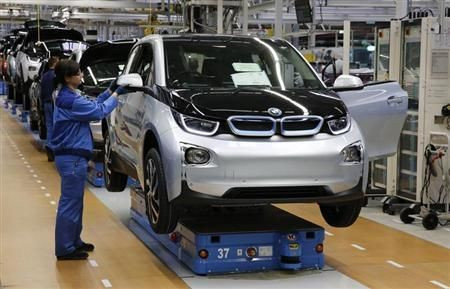BMW i5 Rumor: Next Up For BMW’s Plug-In Sub Brand Could Be A Family-Sized Version Of Its Upcoming i3 Electric Vehicle

Bayerische Motoren Werke AG (FRA:BMW) says demand for its two new plug-ins is strong and this might be emboldening insiders at the world’s largest luxury carmaker to talk about the next introduction in its i-series sub-brand of lightweight low-emission vehicles.
According to BMW insiders who spoke to the British automotive magazine Autocar, BMW has trademarked the names i1 through i8 and that the next vehicle in the series after the i3 all-electric city car and the i8 plug-in hybrid sportscar will likely be called the i5, basically a stretched out version of the i3 aimed at urban families who might be interested in more room, something akin to BMW’s Mini Countryman crossover but built with the carbon fiber re-enforced plastic used for the i3. Lengthening the i3 would be easy, as it would only require using longer aluminum pieces for the chassis, extruding a longer shell to put on top of the frame and adjusting the rear door.
No further details are provided other than speculation that this vehicle would be available sometime in 2015.
After a century of effort, electric vehicles seem to be growing into a viable niche, especially for urban transport where parking and vehicular emissions are bigger issues than they are in the country, where electric vehicle range is a bigger concern.
Telsa Motors Inc. (NASDAQ:TSLA) has said all along that it was starting with the Model S luxury sedan in order to scale toward making a lower-cost EV for the mass market. The big question will be whether the smaller so-called Gen 3 car can exceed its peers in range. Tesla’s Model S has the range thanks to its undercarriage tray containing thousands of 18650 lithium-ion cells that helps push the price tag toward, and in some cases beyond, six figures.
One of the main reasons why other, less costly electric cars on the market don’t come close to the Model S’ 208-to-265-mile range is the size of the battery packs and the types of batteries used. Essentially, automakers such as Nissan, with its Leaf subcompact, have chosen to build smaller, lighter EVs using cheaper lithium-ion battery tech. Tesla will likely need to greatly exceed its peer in range in its sub-$40,000 model, to be out by 2016. Will Tesla be able to top 100 miles or even 200 miles of range for under $40,000? That’s an important question when talking about range and segment types.
Meanwhile, it seems that BMW is fine with making a small EV with sub-100-mile range (albeit a pricey one, starting at over $40,000 and heading to $50,000 with add-ons, including a gas-powered range extending motor), and the company says demand for the i3 has surpassed 10,000 units ahead of its arrival to North America in the spring. The company said recently it has doubled production of carbon fiber from its Moses Lake, Wash., factory to meet the demand.
The i8 hybrid plug-in (with a meager 22 miles of electric only range) expected out by the middle of next year is already sold out for 2014, Ian Robertson, global sales boss at BMW, speaking at the L.A. Auto Show last week, told Reuters.
Whether BMW or any other automaker will beat Tesla to the punch in making a lower cost EV with the price and feel of entry-level luxury has yet to be seen, but one thing is certain: by the time that Gen 3 is on the market there are going to be Gen 3 competitors on the market, too. That’s not something the Model S is contending with right now.
© Copyright IBTimes 2024. All rights reserved.





















